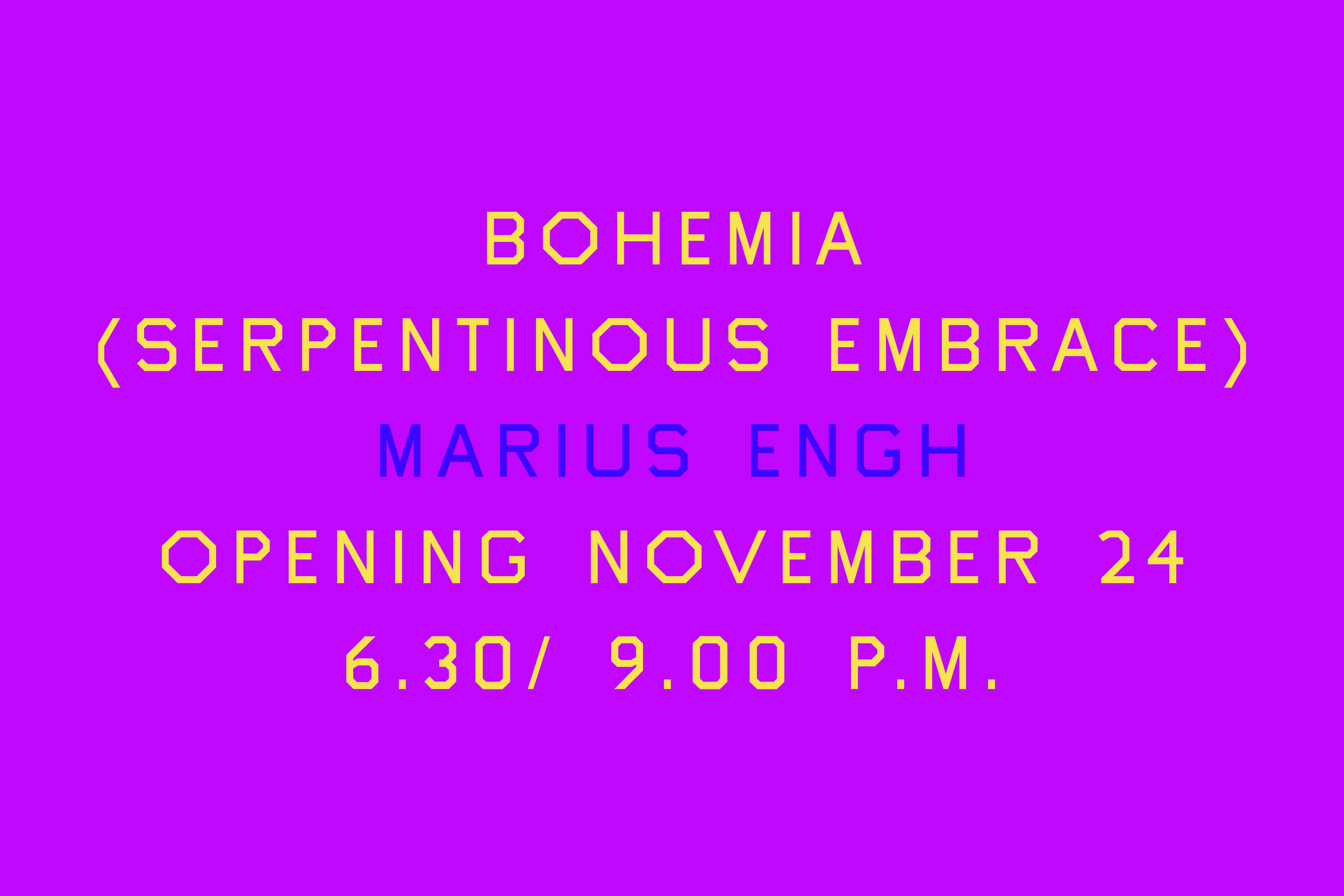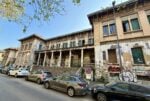Marius Engh – Bohemia (Serpentinous Embrace)

Veda presenta Bohemia (Serpentinous Embrace), una mostra personale di Marius Engh.
Comunicato stampa
Veda presenta Bohemia (Serpentinous Embrace), una mostra personale di Marius Engh.
Le opere presentate sono il frutto della ricerca iniziata da Engh nel 2018 in cui indaga la vita cultu-rale e le idee che scaturiscono dal paesaggio storico, dallo spirito e dall'etimologia del nome Bohe-mia.
Le mostre precedenti con questo titolo sono: Dromomania, Van Etten, Oslo; Phynance Argothique, Hulias, Oslo (2021); Bohemia (Dr. Faustroll's Study), Jane / K.O.S A, Oslo (2021); Bohemia (In the Gesture of Swimming or Praying), Kunstnerforbundet, Oslo (2020); Bohemia (Les Jours et les Nuits), Luis Adelantado, Valencia (2020); Bohemia, K.O.S A, Oslo (2019) e Bohemia (I), VIS, Amburgo (2018).
La mostra, inaugura il 24 novembre 2022 nella sede della galleria in Via delle Cascine 35 e sarà vi-sibile fino al 31 gennaio 2023.
===
Dai, perché voglio, di sicuro ci proverò
Chiquita, ho bisogno di un pezzo di te…
Attaccati dai mostri
Baciando i cani
Fumando e frugando, cambiando in un batter d’occhio
Volo alto vicino alla mia finestra di notte…
Ultimamente un messaggio parla di un posto nel mondo
A poco a poco il mistero comincia a svelarsi
Il serpente è sveglio e vuole un pezzetto della torta
Dai, perché vuoi farlo, sicuramente questo ti farà morire
– Meat Puppets, Attacked by Monsters, SST (1989)
Vi ho raccontato il caso di quella ragazza intuitiva che improvvisamente se ne uscì con l’affermazione di avere un serpente nero nella pancia.
Ebbene, questo è un simbolo collettivo. Non è una fantasia individuale, è una fantasia collettiva.
All’inizio ho pensato che fosse pazza, ma era solo altamente intuitiva. Aveva intuito un’immagine tipica, o archetipica.
– Carl Gustav Jung , Excerpt of interview by Dr. Richard Evans of the University of Houston. Originally released by Penn State University (1957)
Una delle caratteristiche più importanti della mitologia di Hermes è il suo sovrintendere alle comuni relazioni della vita, al traffico, ai viaggi, alle strade, ai confini e così via, e non c’è dubbio che fosse soprattutto in queste relazioni così come in quelle in cui era destinato a essere rappresentato dalle Ermae dei Greci e dai Termini dei Romani, quando questi ultimi erano identificati con le Ermae. È quindi naturale che si debba ricercare l’esistenza di questo simbolo nelle primissime epoche in cui era richiesto l’uso di segni di confine; e in tali epoche i simboli sarebbero stati del carattere più semplice, un mucchio di pietre o un blocco di marmo non sbozzato.
–A Dictionary of Greek and Roman Antiquities (1890) , William Smith, LLD, William Wayte, G. E. Marindin, Ed
======
Marius Engh
Marius Engh (1974, Oslo) considera gli oggetti per la loro capacità di veicolare e trattenere infor-mazioni, come rappresentanti di un modo di vivere quotidiano e standardizzato, la cui funzione e il cui significato si riferiscono a una determinata eredità. Il suo lavoro si appropria di queste forme già esistenti per poi riposizionarle in un altro contesto o sotto nuove letture, creando una sorta di incon-tro formalista la cui espressione scardina la narrazione culturale predominante, così come il modo di relazionarsi con l'ambiente.Una selezione di mostre personali recenti comprende Krutthuset i Mari-dalen (Oslo), Galerie Emanuel Layr (Roma), STANDARD Gallery (Oslo) e VEDA (Firenze). Le sue opere sono state esposte al Musée d'Art Moderne de la Ville de Paris (Parigi), al Munchmuseet (Oslo), al Tenerife Espacio de las Artes (Tenerife), al Glassbox (Parigi), all'Henie Onstad Art Center (Hovik), alla Kunsthall Oslo (Oslo), al Westfälischer Kunstverein (Munster), alla Bergen Kunsthall (Bergen), al Witte de With (Rotterdam) e al Kiasma (Helsinki).
VEDA
Via delle Cascine 35, 50144 Firenze (IT)
[email protected] www.spazioveda.it
@spazioveda #spazioveda #veda
VIA DELLE CASCINE 35 50144 FIRENZE SPAZIOVEDA.IT +39 333 777 3474
VEDA
BOHEMIA (SERPENTINOUS EMBRACE)
MARIUS ENGH
NOVEMBER 24, 2022 – JANUARY 31, 2023
OPENING: NOVEMBER 24 2022, 6.30/9.00 P.M.
Veda presents Bohemia (Serpentinous Embrace), a solo exhibition by Marius Engh.
The works presented are the result of research begun by Engh in 2018 in which he investigates the cultural life and ideas arising from the historical landscape, spirit and etymology of the name Bo-hemia.
Previous exhibitions with this title are: Dromomania, Van Etten, Oslo; Phynance Argothique, Huli-as, Oslo (2021); Bohemia (Dr. Faustroll's Study), Jane / K.O. S A, Oslo (2021); Bohemia (In the Gesture of Swimming or Praying), Kunstnerforbundet, Oslo (2020); Bohemia (Les Jours et les Nuits), Luis Adelantado, Valencia (2020); Bohemia, K.O.S A, Oslo (2019) and Bohemia (I), VIS, Hamburg (2018).
The exhibition opens on 24 November 2022 at the gallery's headquarters in Via delle Cascine 35 and will be on view until January 31, 2023.
===
C’monna, why’want to, surely gonna make it a try
Chiquita, I needa, cut me off a piece of ya…
Attacked by monsters
Kissing dogs
Smoking and poking, changing in the blink of an eye
Fly high by my window at night…
Lately a message talks about a place in the world
Little by little the mystery begins to uncurl
Snakey’s awakey and he wants a little piece o’ the pie
C’monna, why’want to, surely this’ll cause you to die.
– Meat Puppets, Attacked by Monsters, SST (1989)
I told you the case of that intuitive girl who suddenly came out with the statement that she had a black snake in her belly.
Well now, that is a collective symbol. That is not an individual fantasy, it is a collective fantasy.
I first thought perhaps she was crazy, but she was only highly intuitive. She had intuited a typical, or archetypal, image.
– Carl Gustav Jung , Excerpt of interview by Dr. Richard Evans of the University of Houston. Originally released by Penn State University (1957)
One of the most important features in the mythology of Hermes is his presiding over the common intercourse of life, traffic, journeys, roads, boundaries, and so forth, and there can be no doubt that it was chiefly in such relations as these that he was intended to be represented by the Hermae of the Greeks and by the Termini of the Romans, when the latter were identified with the Hermae. It is therefore natural that we should look for the existence of this symbol in the very earliest times in which the use of boundary-marks was required; and in such times the symbols would be of the sim-plest character, a heap of stones or an unhewn block of marble.
–A Dictionary of Greek and Roman Antiquities (1890) , William Smith, LLD, William Wayte, G. E. Marindin, Ed
======
Marius Engh
Marius Engh (1974, Oslo) understands objects by their ability to give and retain information, as re-presentatives of a standardized, everyday way of life whose function and meaning refer to a given inheritance. His work appropriates these already existing forms and then replaces them in another context or under new readings, creating a sort of formalist encounter whose expression displaces the predominant cultural narrative, as well as the way of relating to its environment. A selection of re-cent solo exhibitions includes Krutthuset i Maridalen (Oslo) Galerie Emanuel Layr (Rome), STANDARD Gallery (Oslo) and VEDA (Florence). His works have been included in exhibitions at Musée d’Art Moderne de la Ville de Paris (Paris), Munchmuseet (Oslo), Tenerife Espacio de las Artes (Tenerife), Glassbox, (Paris) Henie Onstad Art Center (Hovik), Kunsthall Oslo, (Oslo), West-fälischer Kunstverein (Munster), Bergen Kunsthall (Bergen), Witte de With (Rotterdam) and Kia-sma (Helsinki).



